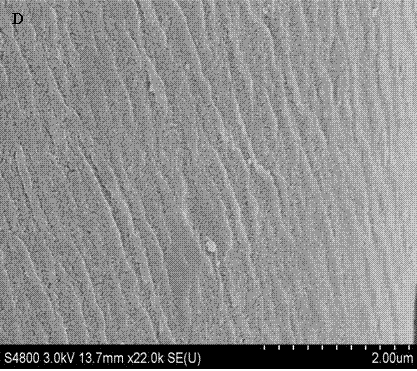Amphoteric cellulose material and application thereof
A technology of amphoteric cellulose and cellulose, applied in other chemical processes, chemical instruments and methods, water/sludge/sewage treatment, etc., can solve the problems of reducing active sites, affecting reactivity, limited adsorption capacity, etc., to achieve Good hydrophilicity, porous microstructure and strong reactivity
- Summary
- Abstract
- Description
- Claims
- Application Information
AI Technical Summary
Problems solved by technology
Method used
Image
Examples
Embodiment 1
[0032] Weigh 10g of cotton fiber, put it in 400ml of 2% sodium hydroxide solution, boil it for 90min, take it out after cooling, squeeze it dry and put it in 300ml of 18% sodium hydroxide solution, let it stand at room temperature After 120 minutes, take it out, wash it with deionized water, and dry it to obtain alkaline cotton fiber.
[0033] Take 5.0g of basic cotton fiber, place it in a three-necked flask filled with 300ml of acetone, slowly add 5ml of sodium hydroxide solution with a mass concentration of 30% under electric stirring, and then add 9g of 3-chloro-2-hydroxypropyl tris Methylammonium chloride was reacted in a water bath at 45°C for 3 hours, and the pH value of the product was adjusted to neutral with dilute hydrochloric acid, filtered with suction, washed with methanol and absolute ethanol in sequence, and dried to constant weight to obtain quaternized cotton fibers.
[0034] Add 5.0g of quaternized cotton fiber and 400ml of deionized water into a three-necked f...
Embodiment 2
[0036] Weigh viscose fiber 10g, place in 300ml mass concentration of 1% sodium hydroxide solution, boil for 60min, take it out after cooling, squeeze dry and place in 280ml mass concentration of 15% sodium hydroxide solution, let stand at room temperature Set it aside for 90 minutes, take it out, wash it with deionized water, and dry it to obtain alkaline viscose fiber.
[0037] Take 6.0g of alkaline viscose fiber, place it in a three-necked flask equipped with 320ml of acetone, slowly add 6ml of a mass concentration of 30% sodium hydroxide solution dropwise under electric stirring, and then add dropwise 15g of 3-chloro-2-hydroxypropyl Trimethylammonium chloride, after reacting in a water bath at 50°C for 200min, adjust the pH value of the product to neutral with dilute hydrochloric acid, filter with suction, wash with methanol and absolute ethanol in sequence, and dry at 40°C to constant weight to obtain quaternized ammonium viscose glue fiber.
[0038] Add 5.0g of quaterniz...
Embodiment 3
[0040] Weigh 10g of microcrystalline cellulose, put it in 250ml of 0.5% sodium hydroxide solution, boil for 60min, filter it with suction after cooling, put it in 200ml of 10% sodium hydroxide solution, and let it stand at room temperature After 120 minutes, take it out, wash it with deionized water, and dry it to obtain alkaline microcrystalline cellulose.
[0041] Take 8.0g of basic microcrystalline cellulose, place in a three-necked flask equipped with 200ml of acetone, slowly add 8ml of a mass concentration of 10% sodium hydroxide solution dropwise under magnetic stirring, and then add dropwise 16g of 3-chloro-2-hydroxypropyl Trimethyl ammonium chloride, after reacting in a water bath at 45°C for 3 hours, adjust the pH value of the product to neutral with dilute hydrochloric acid, filter it with suction and wash it with methanol and absolute ethanol in turn, and dry it at 60°C to constant weight to obtain quaternized ammonium microcrystalline cellulose.
[0042] Add 5.0g ...
PUM
| Property | Measurement | Unit |
|---|---|---|
| adsorption capacity | aaaaa | aaaaa |
| adsorption capacity | aaaaa | aaaaa |
Abstract
Description
Claims
Application Information
 Login to View More
Login to View More - R&D
- Intellectual Property
- Life Sciences
- Materials
- Tech Scout
- Unparalleled Data Quality
- Higher Quality Content
- 60% Fewer Hallucinations
Browse by: Latest US Patents, China's latest patents, Technical Efficacy Thesaurus, Application Domain, Technology Topic, Popular Technical Reports.
© 2025 PatSnap. All rights reserved.Legal|Privacy policy|Modern Slavery Act Transparency Statement|Sitemap|About US| Contact US: help@patsnap.com



